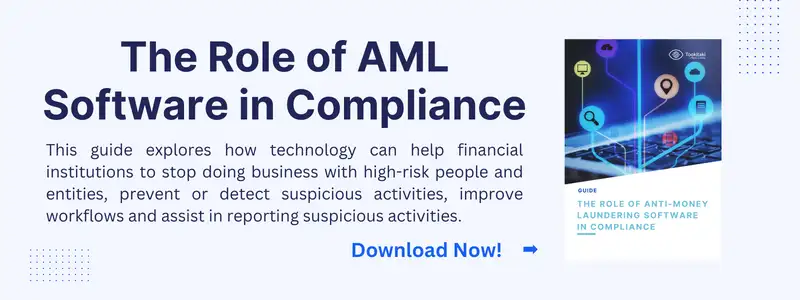In today's global business landscape, the role of third parties in facilitating various operations has become increasingly prevalent. However, this also presents a potential gateway for illicit activities such as money laundering. Understanding the risks, types, and preventive measures associated with third-party money laundering is crucial for businesses and financial institutions alike.
Role of Third Parties in Business Operations
Before delving into the intricacies of money laundering through third parties, it is important to comprehend their role in business operations. Third parties, often intermediaries, provide essential services to businesses, enabling them to function smoothly. These can include suppliers, distributors, agents, consultants, and other service providers.
Third-party relationships can significantly expand a company's reach and capabilities, but they also introduce inherent risks. One such risk is the potential for money laundering.
Moreover, third parties play a crucial role in helping businesses navigate complex regulatory environments. They often possess specialized knowledge and expertise in areas such as legal compliance, environmental regulations, and international trade agreements. By leveraging the services of third parties, companies can ensure that they are operating within the boundaries of the law and meeting all necessary requirements.
Additionally, third parties can act as valuable strategic partners, offering insights and perspectives that may not be readily available within the organization. Collaborating with third parties can bring fresh ideas to the table, foster innovation, and drive competitive advantage in the marketplace. It is essential for businesses to carefully vet and manage their relationships with third parties to maximize the benefits while mitigating potential risks.
How is Money Laundering Possible Through Third Parties?
Money laundering through third parties exploits their involvement in legitimate transactions to obscure the origins of illicit funds. By utilizing these intermediaries, criminals can distance themselves from the illicit proceeds, making detection and tracking more challenging.
Through a complicated web of transactions, criminals can inject dirty money into legitimate business channels. This process typically involves layers of transactions and multiple third parties, making it arduous to trace the source of the funds.
One common method is trade-based money laundering, where invoices are manipulated to overstate or understate the value of goods or services, allowing the movement of illegal funds across borders.
Another way money laundering through third parties can occur is through the use of shell companies. These are often entities that exist only on paper and are used to create a complex network of transactions that obscure the true origin of the funds. Shell companies can be set up in jurisdictions with lax regulations, making it easier for criminals to hide their illicit activities.
Furthermore, money launderers may exploit the services of professional facilitators, such as lawyers or accountants, who can help legitimize the source of funds through complex legal structures. These professionals may knowingly or unknowingly assist in the laundering process, adding another layer of complexity to the illicit scheme.
Types of Money Laundering Through Third Parties
Money laundering through third parties takes various forms, each with its own characteristics and risks. Understanding these methods is crucial for detecting and preventing financial crimes. In addition to the prevalent methods mentioned, there are other intricate ways in which criminals exploit third parties to launder money.
One such method is trade-based money laundering, where criminals manipulate trade transactions to move illicit funds across borders. This can involve misrepresenting the quantity or quality of goods being traded or even falsifying the entire trade altogether. By exploiting the complexities of international trade, criminals can obscure the origin of illicit funds and integrate them into the legitimate economy.
- Shell companies: Criminals establish fictitious businesses to legitimize their illicit funds, often incorporating them in countries with lax regulatory oversight.
- False invoicing and over/under invoicing: By manipulating invoices, criminals hide the true value of the transactions, thus facilitating money laundering.
- Smurfing: This involves breaking down large amounts of illicit funds into smaller, less traceable transactions, often using multiple third parties.
- Nominees and straw men: Criminals employ individuals as nominees or straw men to provide a false sense of legitimacy to their operations, disguising the true beneficial owners.
Risks Associated with Third Party Money Laundering
The involvement of third parties in money laundering activities poses several risks to businesses and financial institutions. These risks include reputational damage, legal ramifications, monetary losses, and regulatory non-compliance.
A tainted reputation can have long-lasting effects on an organization, eroding trust and confidence among stakeholders. Legal consequences, including hefty fines and penalties, can cripple a company financially. Furthermore, failure to comply with anti-money laundering regulations can lead to loss of licenses and severe regulatory scrutiny.
Moreover, the use of third parties in money laundering schemes can also expose businesses to the risk of being unknowingly involved in other criminal activities, such as terrorist financing or drug trafficking. This can not only result in severe legal repercussions but can also tarnish the company's image in the eyes of the public and potential investors.
Additionally, the complexity of third party money laundering schemes can make it challenging for businesses to detect and prevent such activities effectively. Criminal organizations often use sophisticated methods to conceal the illicit origins of funds, making it crucial for companies to have robust anti-money laundering measures in place to safeguard their operations and assets.
The Role of Financial Institutions in Preventing Third-Party Money Laundering
Financial institutions play a vital role in combating third-party money laundering. They are at the forefront of implementing robust preventative measures to detect and deter illicit activities.
By establishing comprehensive Know Your Customer (KYC) procedures, financial institutions can better understand their customers and identify potential risks associated with third-party relationships. This includes conducting thorough due diligence to verify the identity, reputation, and reliability of third parties.
Moreover, financial institutions should enhance their transaction monitoring systems to flag any suspicious activities involving third parties and promptly report them to the relevant authorities.
Additionally, financial institutions often collaborate with regulatory bodies and law enforcement agencies to share information and intelligence on emerging money laundering trends and techniques. This partnership allows for a more coordinated and effective response to combat financial crimes perpetrated by third parties.
Furthermore, continuous training and education programs are essential for financial institution employees to stay abreast of the latest money laundering typologies and compliance requirements. This ongoing education ensures that staff members are equipped to identify red flags and take appropriate actions to prevent third-party money laundering.
Due Diligence to Avoid 3rd Party Money Laundering
Conducting due diligence on third parties is paramount to ensure compliance with anti-money laundering regulations. Companies must implement rigorous procedures that encompass:
- Collecting necessary information to assess the legitimacy of third parties, including identification documents, business records, and references.
- Verifying the credentials, reputation, and financial stability of potential third parties.
- Conducting risk assessments to evaluate the potential exposure to money laundering activities.
- Monitoring and reassessing third-party relationships on an ongoing basis.
When collecting information to assess the legitimacy of third parties, it is crucial for companies to delve deep into the background of these entities. This could involve verifying the ownership structure, understanding the nature of their business operations, and scrutinizing any past legal issues or controversies they may have been involved in. By conducting a thorough investigation, companies can gain a comprehensive understanding of the third party's integrity and reliability.
Furthermore, in the process of verifying the credentials and reputation of potential third parties, companies should not only rely on the information provided by the third party itself but also conduct independent research. This may include checking for any adverse media coverage, consulting industry databases for any red flags, and even seeking feedback from other businesses that have previously engaged with the third party. By cross-referencing information from multiple sources, companies can build a more accurate and reliable profile of the third party's trustworthiness.
Ongoing Checks to Avoid Money Laundering Through Third Parties
Preventing money laundering through third parties requires continuous vigilance and monitoring. Companies should implement ongoing checks to identify any changes in the risk profile of their third-party relationships.
This includes periodically reviewing third-party documentation, conducting site visits, and performing audits. Suspicious patterns or inconsistencies should be promptly investigated and reported to the appropriate authorities, ensuring timely action is taken to prevent money laundering.
Moreover, it is crucial for companies to establish clear communication channels with their third-party partners to ensure transparency and accountability. Regular dialogues and updates can help in maintaining a strong understanding of the business activities and financial transactions of these partners, enabling better risk assessment and detection of potential money laundering activities.
Additionally, companies can leverage technology and data analytics tools to enhance their monitoring capabilities. By implementing advanced software solutions that can analyze large volumes of data in real-time, companies can quickly identify any unusual trends or anomalies in third-party transactions, allowing for immediate investigation and mitigation of money laundering risks.
Implementing Counter Measures
To safeguard against third-party money laundering, companies can implement various countermeasures:
- Establishing a robust internal control framework that includes strict policies, procedures, and guidelines for managing third-party relationships.
- Promoting a strong compliance culture throughout the organization, with clear accountability and oversight.
- Providing comprehensive training to employees to raise awareness about the risks of third-party money laundering and how to detect and report suspicious activities.
- Utilizing technology and data analytics to enhance transaction monitoring capabilities and identify potential anomalies or irregularities in third-party transactions.
Moreover, companies can also consider conducting regular audits and due diligence checks on their third-party partners to ensure compliance with anti-money laundering regulations. These audits can help identify any gaps or weaknesses in the existing control framework and allow for prompt remedial actions to be taken.
Another effective countermeasure is to establish a dedicated compliance team responsible for monitoring and investigating third-party transactions. This team can work closely with law enforcement agencies and regulatory bodies to share information and intelligence on potential money laundering activities, thereby strengthening the company's overall anti-money laundering efforts.
Technology and Innovation in Detecting Third-Party Money Laundering
As criminals constantly adapt their strategies, the use of technology and innovation becomes crucial in detecting and preventing third-party money laundering. Financial institutions and businesses are increasingly leveraging advanced analytics, artificial intelligence, and machine learning algorithms to identify patterns of illicit activity.
These technological advancements can enable proactive monitoring, real-time alerts, and more effective risk assessment. By analyzing vast amounts of data, institutions can rapidly identify suspicious transactions and patterns associated with third-party money laundering, increasing the chances of intervention before substantial harm occurs.
Moreover, the implementation of blockchain technology has shown promise in enhancing the traceability of financial transactions, making it harder for money launderers to conceal their illicit activities. Blockchain's decentralized and transparent nature allows for a secure and tamper-proof record of transactions, providing a valuable tool in the fight against money laundering.
Additionally, biometric authentication methods, such as fingerprint or facial recognition, are being integrated into anti-money laundering processes to enhance security and reduce the risk of identity fraud. These advanced biometric technologies add an extra layer of verification, ensuring that individuals involved in financial transactions are who they claim to be.
How Tookitaki Can Help
Tookitaki, a leading provider of anti-money laundering solutions, offers cutting-edge technology that empowers financial institutions to combat third-party money laundering effectively.
Utilizing artificial intelligence and machine learning algorithms, Tookitaki's platform enables real-time monitoring, seamless integration with existing systems, and proactive detection of suspicious activities.
By leveraging Tookitaki's innovative solutions, financial institutions can strengthen their anti-money laundering capabilities, minimize risks associated with third-party relationships, and fulfill their regulatory responsibilities.
When it comes to combating money laundering, the landscape is constantly evolving. Criminals are becoming more sophisticated in their methods, making it crucial for financial institutions to stay ahead of the game. With Tookitaki's advanced technology, institutions can adapt to these changes quickly and effectively, ensuring that they are always one step ahead of potential threats.
Moreover, Tookitaki's platform not only identifies suspicious activities but also provides valuable insights for ongoing improvement. By analyzing patterns and trends in data, financial institutions can enhance their anti-money laundering strategies and optimize their processes for better results. This proactive approach not only increases efficiency but also reduces the likelihood of regulatory fines and reputational damage.
Don't let the complexities of third-party money laundering undermine the integrity of your financial institution. Embrace the power of Tookitaki's FinCense—an innovative operating system designed to revolutionize your anti-money laundering and fraud prevention strategies. With our federated learning model and comprehensive suite of tools, including Onboarding Suite, FRAML, Smart Screening, Customer Risk Scoring, Smart Alert Management, and Case Manager, you're equipped to detect and combat financial crimes more effectively. Experience fewer false positives, enhanced compliance, and a 360-degree customer risk profile that keeps you ahead of the curve. Ready to fortify your defenses and streamline your FRAML management processes? Talk to our experts today and join the forefront of financial crime prevention with Tookitaki's FinCense platform.
Anti-Financial Crime Compliance with Tookitaki?




